Key takeaways:
- Understanding lighting quality and direction is essential for capturing flattering and emotionally resonant portraits.
- Experimenting with different portrait lighting techniques, such as Rembrandt, loop, and butterfly lighting, can significantly enhance the depth and character of images.
- Using reflectors and soft lighting equipment can create a transformative effect, improving the overall quality of portraits.
- Embracing shadows and understanding the emotional impact of light placement can unlock deeper connections between the subject and the viewer.
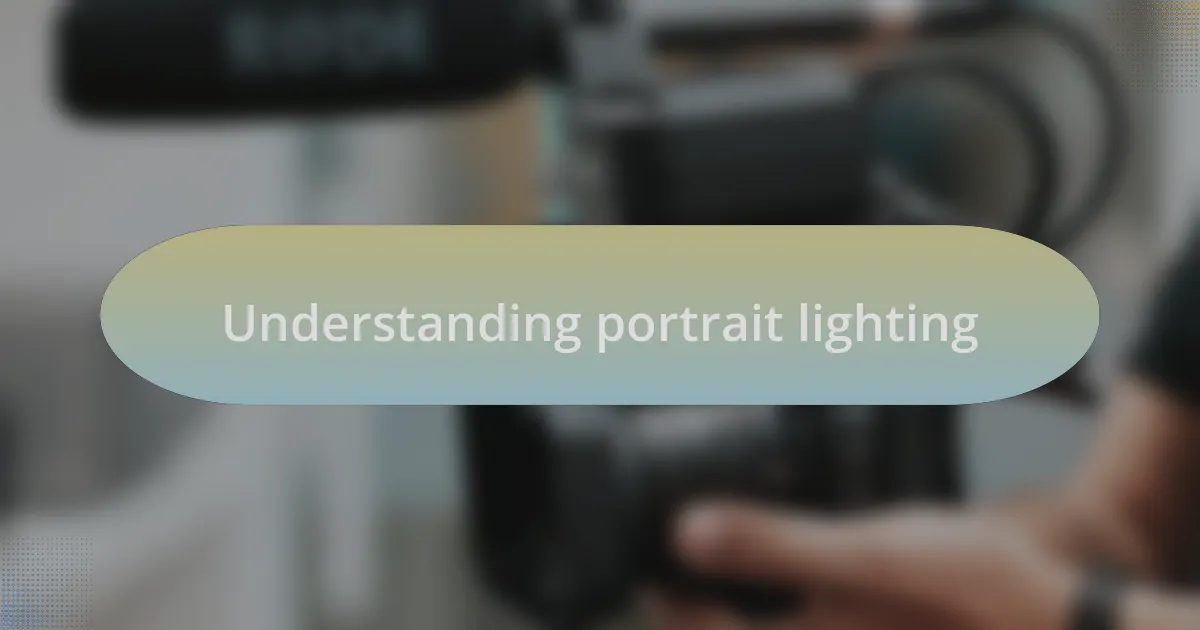
Understanding portrait lighting
Understanding portrait lighting is crucial for capturing the essence of your subject. I remember a time when I shot a portrait in harsh midday sun. The light was unflattering, casting deep shadows on my model’s face, and I learned firsthand how vital it is to control lighting to avoid unintentional distortion of features.
Soft, diffused light can create a warm and inviting atmosphere, and I’ve found that using natural light during the golden hour evokes a certain magic in portraits. Isn’t it fascinating how the direction and quality of light can transform an ordinary photo into an extraordinary one? I’ve experimented with both backlighting and side lighting, and each has produced stunning and varied emotional responses that resonate with viewers.
I often ask myself how to achieve that perfect balance. For instance, when I introduced a reflector to bounce light back onto my subject’s face, it created a gentle highlight that brought the portrait to life. Light is not just an element; it’s a storyteller, shaping the mood and feel of an image. Recognizing how to manipulate it can elevate your portrait photography to new heights.
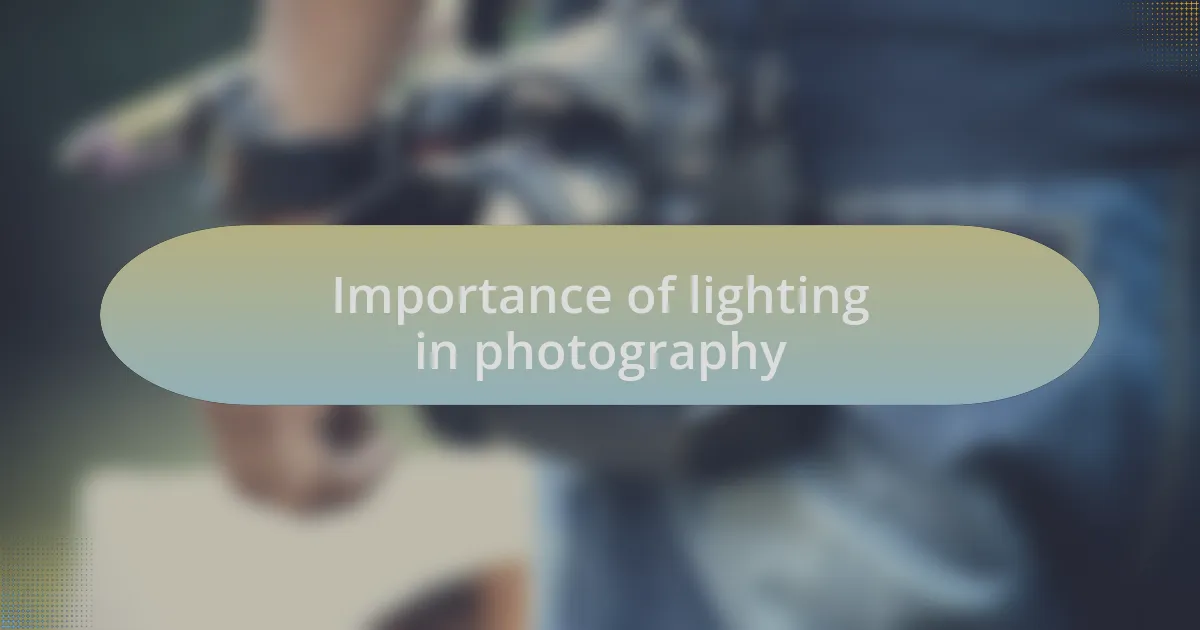
Importance of lighting in photography
Lighting in photography is paramount for defining your subject and setting the mood. I recall a striking moment during an outdoor shoot at dusk; the soft glow of sunset bathed my subject in gold, creating a sense of warmth and intimacy that was simply enchanting. It made me realize how light not only illuminates a scene but also carries emotional weight, capturing feelings that words often fail to convey.
I’ve often found myself amazed by how different lighting conditions can evoke entirely different reactions. For instance, I once tried a dramatic lighting technique that cast long shadows across my subject’s face, resulting in a brooding image that stirred deep emotions. It’s intriguing to think about how a simple adjustment in lighting can manipulate the story being told in a photograph—what do you want your audience to feel when they look at your work?
The importance of lighting extends beyond aesthetics; it can make or break a portrait. During a recent indoor session, I positioned my subject near a large window, and the natural light that filtered through added a soft halo effect. This not only highlighted the subject’s features beautifully but also created a connection between the viewer and the photograph. I can’t help but ponder: how often do we overlook the transformative power of light in our work?
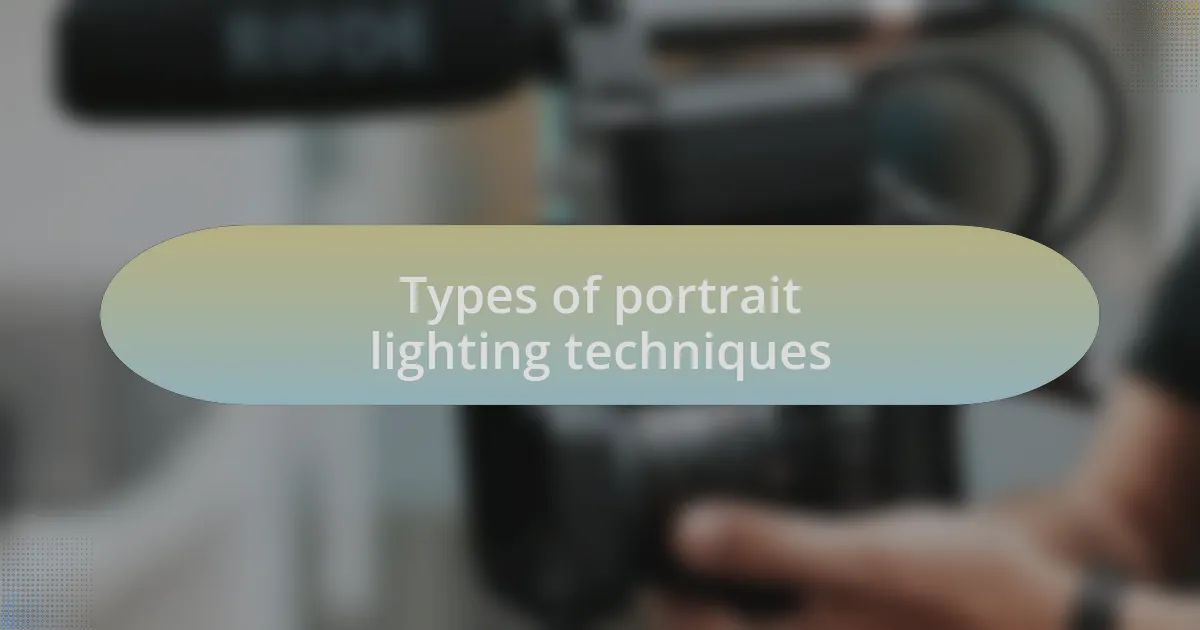
Types of portrait lighting techniques
When it comes to portrait lighting techniques, three stand out: Rembrandt, butterfly, and loop lighting. I remember my first encounter with Rembrandt lighting during a workshop; the way the triangular patch of light appeared under my subject’s eye was fascinating. This technique creates depth and dimension, perfect for adding visual interest and emotional complexity to a portrait—don’t you think it’s incredible how a simple shadow can enhance character?
Loop lighting is another favorite of mine, as it creates a soft light that highlights the facial contours without being too harsh. I once experimented with this technique on a friend’s shoot; the subtle loop shadow next to her nose created a healthy glow that made her look radiant and full of life. It’s moments like these that make me realize how the right technique can elevate a portrait from ordinary to extraordinary.
Butterfly lighting, characterized by the shadow cast beneath the nose resembling a butterfly, has a special place in my heart. I used this method for a vintage-inspired photo session, and the gentle illumination emphasized the elegance of my subject, capturing her in a way that felt timeless. How often do we find beauty in these specific details? In each of these techniques, I’ve discovered that the play of light and shadow can dramatically transform the story my portraits tell.

Equipment I use for lighting
When it comes to equipment, I primarily rely on a softbox and a speedlight. The softbox provides a diffused, flattering light that softens harsh shadows, and I vividly recall a portrait session where my softbox made a world of difference. The way it enhanced the texture of my subject’s skin was remarkable—didn’t realize how much of a difference quality light could make until that day.
For outdoor shoots, I always have a reflector on hand. I had a memorable experience using it during a golden hour session; the way it bounced sunlight onto my subject illuminated their features beautifully. It’s fascinating how a simple tool like a reflector can create that extra pop, turning an already stunning sunset into a magical portrait moment—who knew catching that light could be so transformative?
I also invest in a high-quality LED panel, which is fantastic for low-light scenarios. I remember a night shoot where my LED panel became my primary light source; it allowed me to be creative with the environment while ensuring my subject was perfectly lit. The ability to adjust brightness and color temperature on the fly is invaluable—what photographer wouldn’t want that kind of versatility?
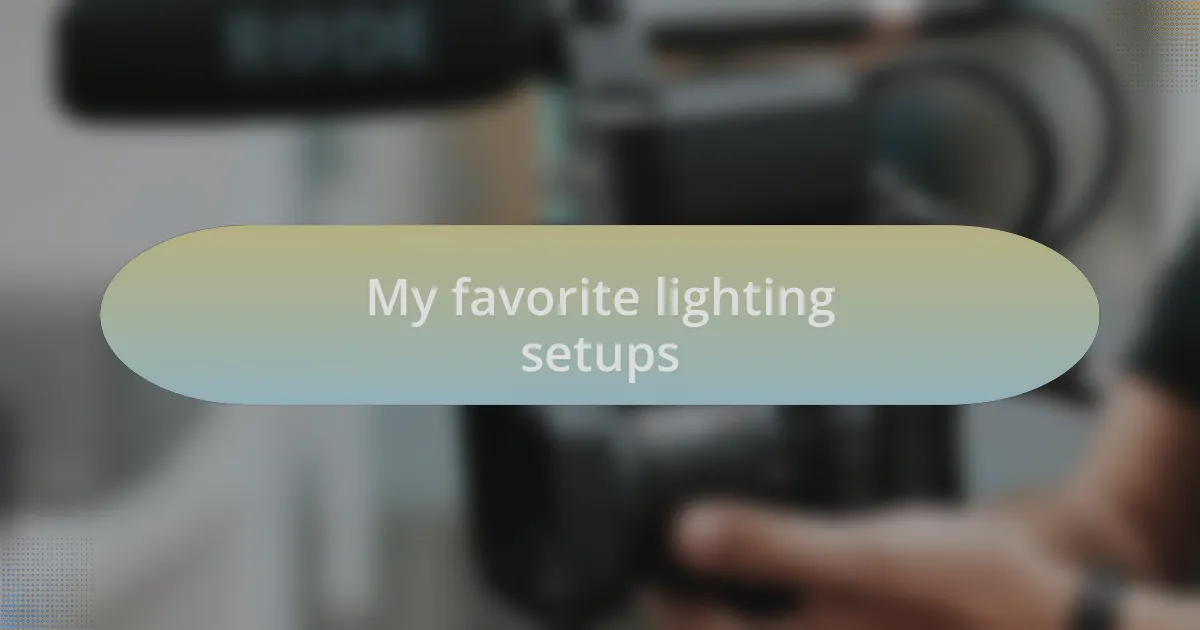
My favorite lighting setups
When it comes to my favorite lighting setups, I often find joy in utilizing a simple two-light configuration. One light acts as my key light, placed at a 45-degree angle to the subject, while the second serves as a fill light. During one particularly rewarding shoot, I realized how this setup added depth and dimension; it was like painting with light. I couldn’t help but smile as I captured the intricate play of shadows across my subject’s face, transforming the portrait into a work of art.
Another setup I adore is using backlighting, which creates a beautiful rim effect that adds a sense of drama and ethereality. I vividly remember a session in a park at dusk when the sun dipped below the horizon, casting a golden halo around my subject. The sheer joy of seeing them illuminated against the fading light sparked my creativity, prompting me to experiment with different angles and compositions. Isn’t it amazing how backlighting can turn an ordinary moment into something extraordinary?
Finally, I find immense value in hard light for its ability to create striking contrasts and bold shadows. I once did a series of dramatic black-and-white portraits using harsh midday sun. The results were stark yet compelling, and it reminded me how sometimes we need to embrace the challenges of lighting. It begs the question: what will you discover by stepping outside your comfort zone?
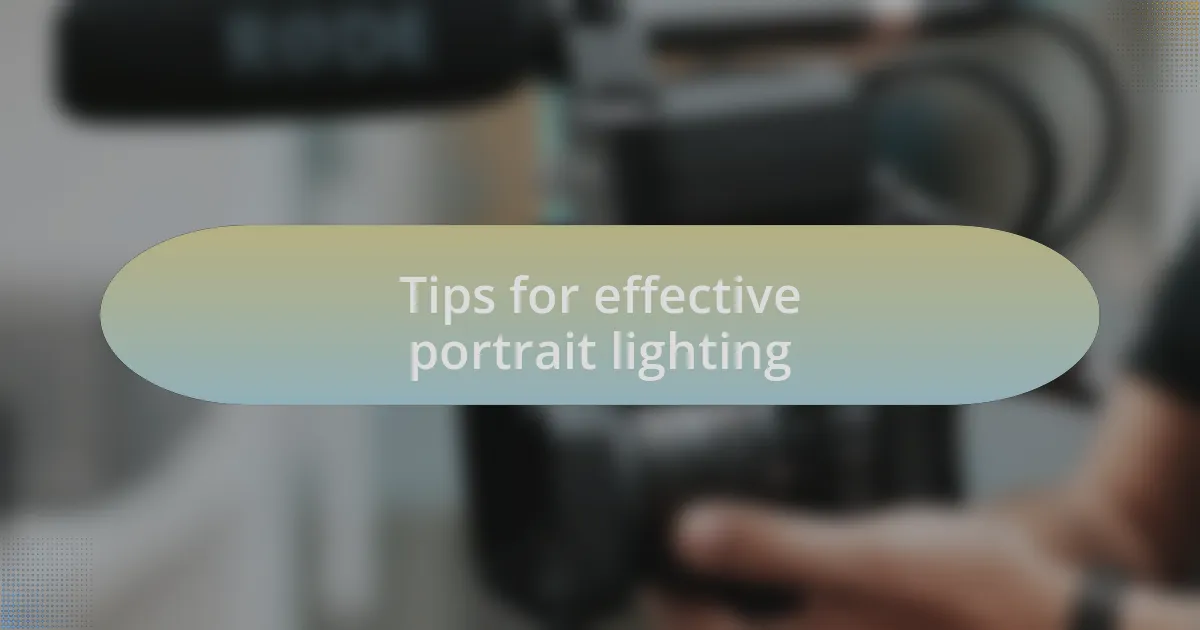
Tips for effective portrait lighting
When I’m preparing for a portrait session, one of the first things I consider is the quality of light. Soft, diffused light can work wonders for flattering skin tones. I remember a late afternoon shoot at a local café where the sunlight spilled through sheer curtains, creating a softness that enveloped my subject like a gentle embrace. It made me think: how often do we overlook the effect of natural elements on our photography?
Another critical aspect is the direction of light. I typically experiment with the light’s source until I find that perfect positioning. There’s something magical about side lighting; it emphasizes textures and contours, bringing out the character of the subject. One time, I shot a portrait of a friend in my living room during golden hour. The way the light sculpted her features revealed emotions I hadn’t expected. Have you ever noticed how light can speak louder than words?
Lastly, using reflectors in my setups has significantly enhanced my portraits. They provide that extra boost of illumination to the shadows, ensuring a balanced look. I once used a simple white reflector during a shoot in a park, and the results were stunning. It transformed the image, adding life and vibrancy to the colors. Isn’t it fascinating how such a small tool can have such a big impact?
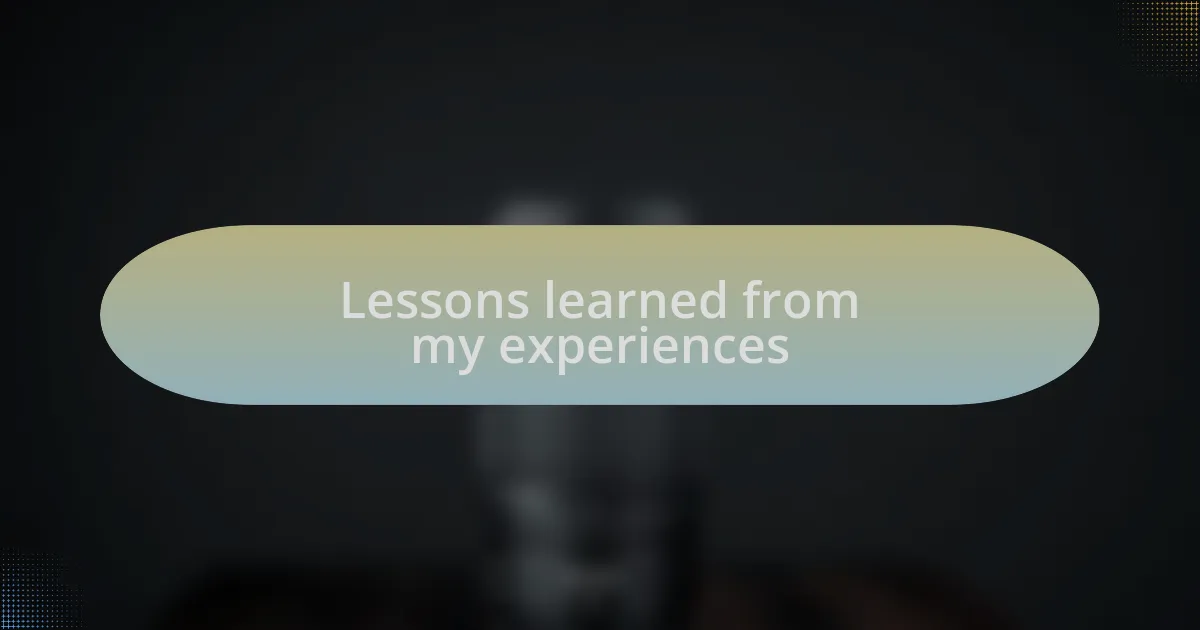
Lessons learned from my experiences
One lesson I’ve taken to heart is the importance of understanding the different qualities of light throughout the day. I recall a portrait session at a beach just before sunset, where the golden hour light brought an ethereal glow to the scene. In that moment, I realized how time of day can shape not just the photograph but also the mood and storytelling within it. Have you ever noticed how the light seems to transform everything?
Another valuable insight is the impact of light placement on the subject’s emotions. During a shoot with a shy teenager, I positioned the light slightly above and in front, which allowed her to connect with her inner confidence. As I captured her expressions, I could see how the lighting choice bolstered her ease in front of the camera. Isn’t it incredible how simply changing the light can unlock someone’s true self?
Additionally, I’ve learned to embrace shadows instead of shying away from them. During one memorable urban portrait session, I played with harsh, direct light that cast dramatic shadows on my subject’s face. This bold choice added layers of intrigue and depth to the composition. It made me ponder: what stories can shadows tell in our photographic narratives? Each experiment in lighting has taught me that even imperfections can add a unique character to our work.